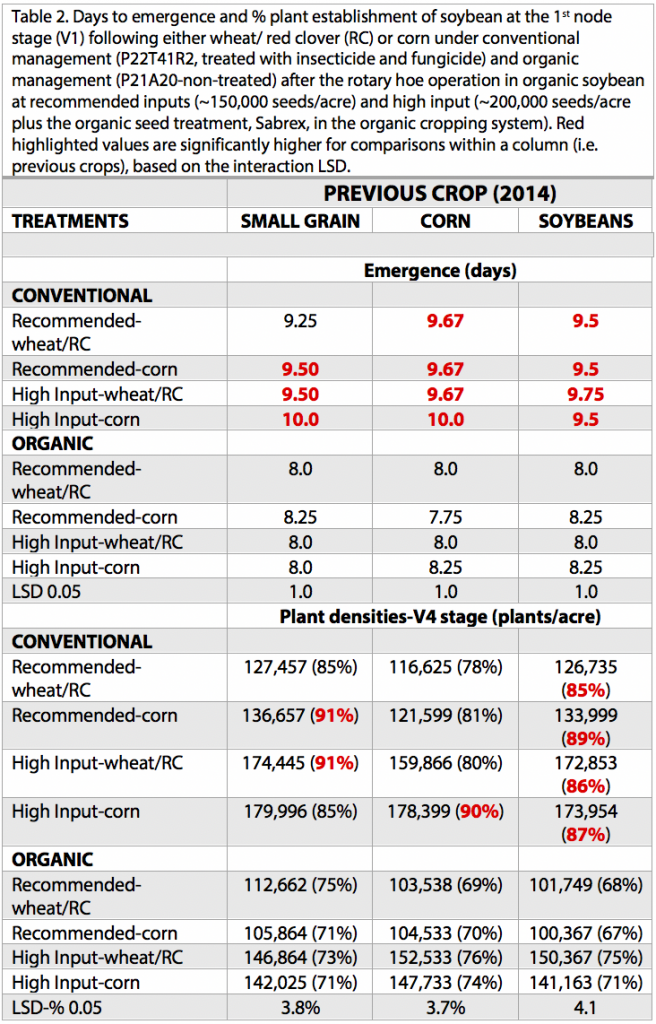Bill Cox, Eric Sandsted, and Phil Atkins

We initiated a 4-year study at the Aurora Research Farm in 2015 to compare different sequences of the corn-soybean-wheat/red clover rotation in conventional and organic cropping systems under recommended and high input management during the transition period (and beyond) to an organic cropping system. Unfortunately, we were unable to plant wheat after soybean in the fall of 2016 because green stem in soybean, compounded with very wet conditions in October and early November, delayed soybean harvest until November 9, too late for wheat planting. Consequently, soybean followed corn as well as wheat/red cover in 2018 so we are now comparing different sequences of the corn-soybean-wheat/red clover rotation with a corn-soybean rotation (Table 1). This article will focus on soybean emergence (days) and early plant densities (% early plant establishment) at the early 1st node stage (V1 stage) in 2018. 

The fields were plowed on May 17 and then cultimulched on the morning of May 18, the day of planting. We used the White Air Seeder to plant the treated (insecticide/fungicide) GMO soybean variety, P22T41R2, and the non-treated non-GMO variety, 921A20, at two seeding rates, ~150,000 (recommended input) and ~200,000 seeds/acre (high input). P21A20 is a not an isoline of P22T41R2 so only the maturity of the two varieties and not the genetics are similar between the two cropping systems. We treated the non-GMO, 921A20, in the seed hopper with the organic seed treatment, Sabrex, in the high input treatment (high seeding rate). We used the typical 15” row spacing in conventional soybean and the typical 30” row spacing (for cultivation of weeds) in organic soybean. Consequently, the soybean comparison is not as robust as the corn or wheat comparisons in this study because of the different row spacing and genetics between the two cropping systems.
Warm conditions (64.7 F average temperature and 0.81 inches of precipitation) during the 10 days following planting resulted in fairly rapid emergence. Organic soybean required about 8 days for emergence but conventional soybean required about 9.5 days (Table 2). The more rapid soybean emergence in the organic system is similar to previous years (https://blogs.cornell.edu/whatscroppingup/2017/06/06/soybean-emergence-and-early-plant-densities-v1-v2-stage-in-conventional-and-organic-cropping-systems-in-2017/). In previous years, however, variety differences rather than cropping system differences probably influenced days to emergence with P92Y21, the variety used in the organic system from 2015-2017, with a higher field emergence score (8 out of 10 rating) compared with P22T41R2 (7 out of 10). In 2018, however, we had to switch to P21A20 (P92Y21 no longer available), which had the same field emergence rating (7 out of 10) as P22T41R2. So variety differences probably did not contribute to emergence differences between the two cropping systems. The organic cropping system also was planted in 30 inch rows so there were 8.5 to 11.5 seeds emerging per 1 foot of row in the organic system compared with 4.25 to 5.75 seeds emerging in 1 foot of row in the conventional system. In 2018, however, there was no real soil crust because of intermittent rains after planting so seed spacing within the row was probably not a factor. The final factor to consider is that the insecticide/fungicide seed treatment may have delayed emergence in conventional soybean, as it seemed to delay wheat emergence (https://blogs.cornell.edu/whatscroppingup/2017/12/01/organic-compared-with-conventional-wheat-once-again-has-more-rapid-emergence-greater-early-season-plant-densities-and-fewer-fall-weeds-when-following-soybean-in-no-till-conditions/).
We estimated soybean plant densities at the early V1 stage (June 1), about a week after the rotary hoeing operation in organic soybean. Conventional soybean generally had higher plant establishment rates (78-91%) compared with organic soybean (67 to 76%, Table 2). In previous years, conventional vs. organic soybeans had greater early plant establishment (2016), lower early plant establishment (2017), or similar early plant establishment rates (2015). We did note some damage, but relatively low damage, to organic soybean from the rotary hoe operation, which occurred 6 days after planting. Based on previous data, however, we do not think that rotary hoe damage was totally responsible for the 10 to 15% lower plant establishment rate in organic soybeans. The higher compared with recommended input treatment of organic soybean had higher early plant establishment rates in fields with corn and soybean as the 2014 crops so perhaps the use of the Sabrex seed treatment improved early plant establishment.
In conclusion, early plant populations in conventional soybean (15-inch rows) in the recommended input treatment exceeded the 114,000 plant/acre threshold limit for maximum soybean yields in NY. Consequently, both high and recommended input treatments in conventional soybean have similar yield potential at this stage of development. We have not really established a plant/acre threshold limit for organic soybeans in New York (because very few soybeans are grown in 30-inch rows) so it is not clear if early plant stands of 100,000 to 105,000 plants/acre are adequate for maximum yield. Conceivably, more plants will emerge after our stand counts to increase early plant establishment rates in organic soybean. On the other hand, future cultivations, especially the close to the row cultivation, could decrease organic soybean stands by another 5%. Furthermore, lower stands in the recommended input treatment of organic soybean may allow for increased weed interference, which has the potential to reduce yields. Ironically, the year that organic compared with conventional soybean had greater early plant establishment rate was the only year (2017) that organic soybean yielded lower. It will be interesting to see how the 2018 soybean growing season plays out.


